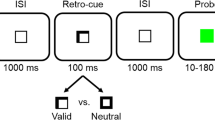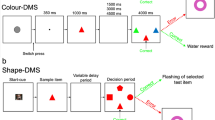Abstract
The influence of emotional valence (positive, negative or neutral) of realistic images on the functioning of visual working memory (WM) was studied in adults (n = 40) and adolescents (n = 17). In adults, emotional coloring of stimuli increased the reaction time and decreased the accuracy of WM task performance. This effect was more pronounced for negative than for positive valence: the minimal reaction time was observed for the neutral stimuli, the maximal for the negative emotional stimuli, and significant differences in the reaction time were found between all three types of images. The accuracy was lower for negative stimuli than for either positive or neutral stimuli. Compared with adults, adolescents of age 14–16 showed lower indices of the performance accuracy and rate with neutral and positive stimuli in the WM task. In this group, no significant influence of the emotional valence of visual stimuli on the accuracy of WM task performance was found.
Similar content being viewed by others
References
Anokhin, P.K., The main problems in the study of conditioned reflex, in Problemy vysshei nervnoi deyatel’nosti (Problems of Higher Nervous Activity), Anokhin, P.K, Ed., Moscow: Akad. Med. Sci. SSSR, 1949.
Simonov, P.V., Emotsional’nyi mozg (The Emotional Brain), Moscow: Nauka, 1981.
Viliunas, V.K., Major issues of the psychological theory of emotions, in Psikhologiya emotsii. Ser. Khrestomatiya po psikhologii (Psychology of Emotions. Ser. Anthology of Psychology), St. Petersburg: Piter, 2006, p. 8.
Baddeley, A., Working memory, Science, 1992, vol. 255, no. 5044, p. 556.
Banich, M.T., Mackiewicz, K.L., Depue, B.E., et al., Cognitive control mechanisms, emotion and memory: A neural perspective with implications for psychopathology, Neurosci. Biobehav. Rev., 2009, vol. 33, no. 5, p. 613.
Nee, D.E., Brown, J.W., Askren, M.K., et al., A metaanalysis of executive components of working memory, Cereb. Cortex, 2012. doi 10.1093/cercor/bhs007.
Gathercole, S.E., Pickering, S.J., Knight, C., and Stegmann, Z., Working memory skills and educational attainment: evidence from national curriculum assessments at 7 and 14 years of age, Appl. Cognit. Psychol., 2004, vol. 18, no. 1, p. 1.
Shah, P. and Miyake, A., Models of working memory, in Models of Working Memory: Mechanisms of Active Maintenance and Executive Control. An Introduction, New York: Cambridge Univ. Press, 1999, p. 1.
Baddeley, A., Working memory: Looking back and looking forward, Nat. Rev. Neurosci., 2003, vol. 4, no. 10, p. 829.
D’Esposito, M., From cognitive to neural models of working memory, Philos. Trans. R. Soc. London, Ser. B, 2007, vol. 362, no. 1481, p. 761.
Nee, D.E. and D’Esposito, M., Working memory, in Brain Mapping, Toga, A.W., Ed., Waltham: Academic, 2015, vol. 2, pp. 589.
Gazzaley, A. and Rissman, J., and D’Esposito, M., Functional connectivity during working memory maintenance, Cognit. Affective Behav. Neurosci., 2004, vol. 4, no. 4, p. 580.
Ranganath, C., DeGutis, J., and D’Esposito, M., Category-specific modulation of inferior temporal activity during working memory encoding and maintenance, Cognit. Brain Res., 2004, vol. 20, no. 1, p. 37.
Gazzaley, A., Influence of early attentional modulation on working memory, Neuropsychologia, 2011, vol. 49, no. 6, p. 1410.
Dolcos, F. and McCarthy, G., Brain systems mediating cognitive interference by emotional distraction, J. Neurosci., 2006, vol. 26, no. 7, p. 2072.
Dolcos, F., Diaz-Granados, P., Wang, L., and McCarthy, G., Opposing influences of emotional and nonemotional distracters upon sustained prefrontal cortex activity during a delayed-response working memory task, Neuropsychologia, 2008, vol. 46, no. 1, p. 326.
McRae, K., Hughes, B., Chopra, S., et al., The neural bases of distraction and reappraisal, J. Cognit. Neurosci., 2010, vol. 22, no. 2, p. 248.
Perlstein, W.M., Elbert, T., and Stenger, V.A., Dissociation in human prefrontal cortex of affective influences on working memory-related activity, Proc. Natl. Acad. Sci. U.S.A., 2002, vol. 99, no. 3, p. 1736.
Mather, M., Mitchell, K.J., Raye, C.L., et al., Emotional arousal can impair feature binding in working memory, J. Cognit. Neurosci., 2006, vol. 18, no. 4, p. 614.
Osaka, M., Yaoi, K., Minamoto, T., and Osaka, N., When do negative and positive emotions modulate working memory performance?, Sci. Rep., 2013, vol. 3, pp. 1375.
Erk, S., Kleczar, A., and Walter, H., Valence-specific regulation effects in a working memory task with emotional context, NeuroImage, 2007, vol. 37, no. 2, p. 623.
Ochsner, K.N., Silvers, J.A., and Buhle, J.T., Functional imaging studies of emotion regulation: a synthetic review and evolving model of the cognitive control of emotion, Ann. N. Y. Acad. Sci., 2012, vol. 1251, no. 1, p. 1.
Gray, J.R., Emotional modulation of cognitive control: approach-withdrawal states double-dissociate spatial from verbal two-back task performance, J. Exp. Psychol., Gen., 2001, vol. 130, no. 3, p. 436.
Daneman, M. and Carpenter, P.A., Individual differences in working memory and reading, J. Verb. Learn. Verb. Behav., 1980, vol. 19, no. 4, p. 450.
Lavric, A., Rippon, G., and Gray, J.R., Threat-evoked anxiety disrupts spatial working memory performance: an attentional account, Cognit. Ther. Res., 2003, vol. 27, no. 5, p. 489.
Panksepp, J., Affective Neuroscience: The Foundations of Human and Animal Emotions, New York: Oxford Univ. Press, 1998.
Lindquist, K.A., Wager, T.D., Kober, H., et al., The brain basis of emotion: a meta-analytic review, Behav. Brain Sci., 2012, vol. 35, no. 3, p. 121.
Touroutoglou, A., Lindquist, K.A., Dickerson, B.C., and Barrett Feldman, L., Intrinsic connectivity in the human brain does not reveal networks for “basic” emotions, Soc. Cognit. Affective Neurosci., 2015, vol. 10, no. 9, p. 1257.
Lee, Y.Y. and Hsieh, S., Classifying different emotional states by means of EEG-based functional connectivity patterns, PLoS One, 2014, vol. 9, no. 4, e95415.
Barrett, L.F. and Wager, T.D., The structure of emotion evidence from neuroimaging studies, Curr. Dir. Psychol. Sci., 2006, vol. 15, no. 2, p. 79.
Mozgovye mekhanizmy formirovaniya poznavatel’noi deyatel’nosti v predshkol’nom i mladshem shkol’nom vozraste (Brain Mechanisms of the Formation of Cognitive Activity in the Adolescent and Primary School Age), Machinskaya, R.I. and Farber, D.A., Eds., Moscow: NOU VPO Mosk. Psikhol.-Sots. Univ., 2014.
Casey, B.J., Jones, R.M., and Hare, T.A., The adolescent brain, Ann. N. Y. Acad. Sci., 2008, vol. 1124, pp. 111.
Steinberg, L., Cognitive and affective development in adolescence, Trends Cognit. Sci., 2005, vol. 9, no. 2, p. 69.
Giedd, J.N., The teen brain: insights from neuroimaging, J. Adolesc. Health, 2008, vol. 42, no. 4, p. 335.
Farber, D.A. and Ignat’eva, I.S., Influence of neuroendocrine shifts in the pubertal period on the working memory operation in adolescents, Hum. Physiol., 2006, vol. 32, no. 1, p. 1.
Gathercole, S.E., Pickering, S.J., Ambridge, B., and Wearing, H., The structure of working memory from 4 to 15 years of age, Dev. Psychol., 2004, vol. 40, no. 2, p. 177.
Luciana, M., Conklin, H.M., Hooper, C.J., and Yarger, R.S., The development of nonverbal working memory and executive control processes in adolescents, Child Dev., 2005, vol. 76, no. 3, p. 697.
Conklin, H.M., Luciana, M., Hooper, C.J., and Yarger, R.S., Working memory performance in typically developing children and adolescents: behavioral evidence of protracted frontal lobe development, Dev. Neuropsychol., 2007, vol. 31, no. 1, p. 103.
Olesen, P.J., Macoveanu, J., Tegnér, J., and Klingberg, T., Brain activity related to working memory and distraction in children and adults, Cereb. Cortex, 2007, vol. 17, no. 5, p. 1047.
Tottenham, N., Hare, T.A., and Casey, B.J., Behavioral assessment of emotion discrimination, emotion regulation, and cognitive control in childhood, adolescence, and adulthood, Front. Psychol., 2011, vol. 2, art. 39, p. 1.
Tavitian, L.R., Ladouceur, C.D., Nahas, Z., et al., Neutral face distractors differentiate performance between depressed and healthy adolescents during an emotional working memory task, Eur. Child Adolesc. Psychiatry, 2014, vol. 23, no. 8, p. 659.
Ladouceur, C.D., Silk, J.S., Dahl, R.E., et al., Fearful faces influence attentional control processes in anxious youth and adults, Emotion (Washington, DC), 2009, vol. 9, no. 6, p. 855.
Mueller, S.C., The influence of emotion on cognitive control: relevance for development and adolescent psychopathology, Front. Psychol., 2011, vol. 2, art. 327, p. 1.
Passarotti, A.M., Sweeney, J.A., and Pavuluri, M.N., Emotion processing influences working memory circuits in pediatric bipolar disorder and attention deficit hyperactivity disorder, J. Am. Acad. Child Adolesc. Psychiatry, 2010, vol. 49, no. 10, p. 1064.
Bradley, M.M. and Lang, P.J., The International Affective Picture System (IAPS) in the study of emotion and attention, in Handbook of Emotion Elicitation and Assessment, Coan, J.A. and Allen, J.J.B, Eds., Oxford Univ. Press, 2007, p. 29.
Lang, P.J., Bradley, M.M., and Cuthbert, B.N., International affective picture system (IAPS): affective ratings of pictures and instruction manual, in Technical Report A-8. University of Florida, Gainesville, 2008.
Dan-Glauser, E.S. and Scherer, K.R., The Geneva affective picture database (GAPED): a new 730-picture database focusing on valence and normative significance, Behav. Res. Methods, 2011, vol. 43, no. 2, p. 468.
Luck, S.J. and Vogel, E.K., The capacity of visual working memory for features and conjunctions, Nature, 1997, vol. 390, no. 6657, p. 279.
Fernández-Rey, J. and Redondo, J., Recognition memory for pictorial stimuli: biasing effects of stimulus emotionality, Psicothema, 2007, vol. 19, no. 3, p. 375.
Maljkovic, V. and Martini, P., Short-term memory for scenes with affective content, J. Vision, 2005, vol. 5, no. 3, p. 215.
Rozovskaya, R.I., Pechenkova, E.V., Mershina, E.A., and Machinskaya, R.I., fMRI study of retention of images with different emotional valence in the working memory, Psikhol. Zh. Vyssh. Shk. Ekon., 2014, vol. 11, no. 1, p. 27.
Machinskaya, R.I., Brain regulatory systems, Zh. Vyssh. Nervn. Deyat. im. I.P. Pavlova, 2015, vol. 56, no. 1, p. 33.
Frankenberger, K.D., Adolescent egocentrism: A comparison among adolescents and adults, J. Adolesc., 2000, vol. 23, no. 3, p. 343.
Elkind, D., Egocentrism in adolescence, Child Dev., 1967, vol. 38, no. 4, p. 1025.
Crone, E.A., Wendelken, C., Donohue, S., et al., Neurocognitive development of the ability to manipulate information in working memory, Proc. Natl. Acad. Sci. U.S.A., 2006, vol. 103, no. 24, p. 9315.
Luna, B., Developmental changes in cognitive control through adolescence, Adv. Child Dev. Behav., 2009, vol. 37, pp. 233.
Author information
Authors and Affiliations
Corresponding author
Additional information
Original Russian Text © R.I. Rozovskaya, R.I. Machinskaya, E.V. Pechenkova, 2016, published in Fiziologiya Cheloveka, 2016, Vol. 42, No. 1, pp. 82–93.
The article was translated by the authors.
Rights and permissions
About this article
Cite this article
Rozovskaya, R.I., Machinskaya, R.I. & Pechenkova, E.V. The influence of emotional coloring of images on visual working memory in adults and adolescents. Hum Physiol 42, 69–78 (2016). https://doi.org/10.1134/S0362119716010138
Received:
Published:
Issue Date:
DOI: https://doi.org/10.1134/S0362119716010138




